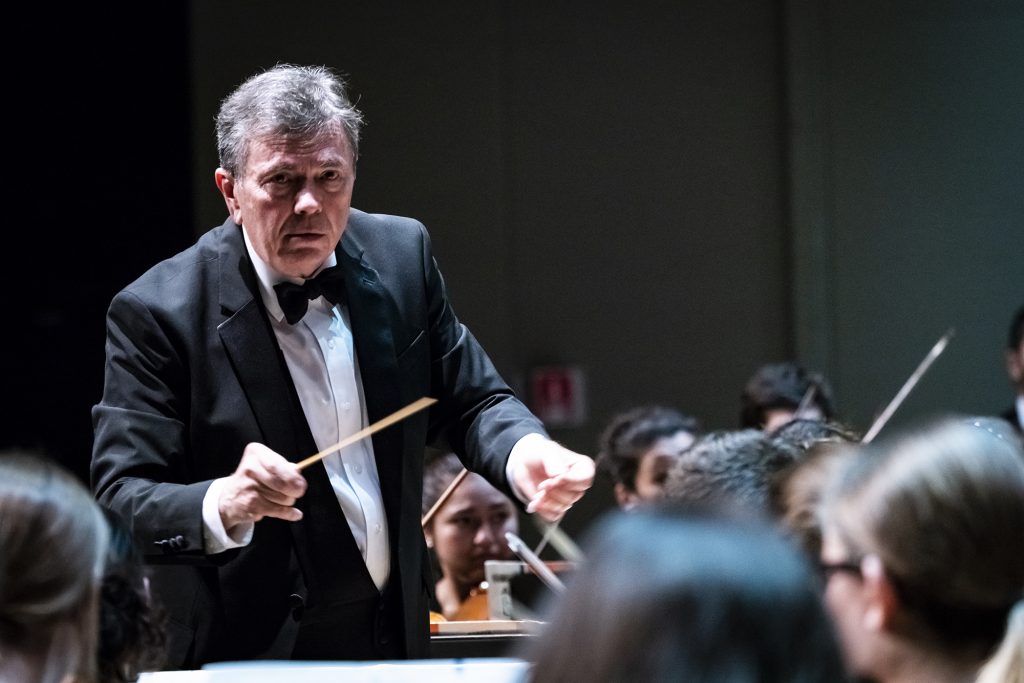Schwarz wraps Frost Symphony season with eclectic mix

Throughout this pandemic-plagued season, the intrepid Gerard Schwarz has continued to make music with the student players of the University of Miami’s Frost School of Music. While the concerts have been open only to students and faculty due to Covid 19 concerns, they have been streamed live from UM Gusman Concert Hall via YouTube.
On Saturday night Schwarz concluded the season of the Frost Chamber Orchestra and Frost Symphony Orchestra with a typically generous program that mixed music of the classical and romantic eras with works by a gifted African-American composer whose scores are heard too infrequently.
With the chamber orchestra on stage for the program’s first half, Schwarz opened with a strongly conceived reading of Mozart’s Symphony No. 35 in D Major (“Haffner”). Avoiding powdered-wig pomposity, this was a Mozart performance with weight and real heft. The full ensemble displayed corporate power in the opening Allegro con spirito. Inner instrumental voices emerged with transparency and the lower strings and timpani were clearly audible. Schwarz stressed the operatic side of Mozart’s oeuvre in the Andante. Smoothly coordinated strings and astutely blended winds made the principal melody really sing. Avoiding the tendency to play the Presto finale at top speed, dynamic contrasts were finely etched and the final pages infused with verve. Despite the distancing of the players on stage, corporate ensemble emerged tight and well-coordinated.
Frost faculty member Kevin Kenner was soloist in Chopin’s Piano Concerto No. 2 in F minor. Kenner was second prize winner at Warsaw’s International Chopin Competition in 1990 (which was the top prize that year as no first prize was awarded). He has lost none of his special affinity for the shape and pulse of the Polish master’s keyboard output.
Schwarz brought urgency to the orchestral introduction of the first movement. Kenner’s finely sensitive touch exquisitely etched the bel canto patterns of the Larghetto and conveyed the spirit of the concluding mazurka in incisive terms. The cascading roulades of notes in the coda were carried off with fleet precision. Schwarz, an expert accompanist, was in synch with Kenner from the piano’s first entrance and drew excellent playing from the reduced orchestra. Kenner received an enthusiastic ovation for his idiomatic performance.
During intermission Frost brass players traversed two scores by Ulysses Kay (1917-1995) outside the hall. Their prerecorded versions of these vignettes were presented as part of the video stream. Kay’s Three Fanfares for Four Trumpets and Brass Quartet (made up of two trumpets and two trombones) interchange martial themes in the manner of Gustav Holst’s wind band compositions with a bluesy subtext. The players gave high voltage performances of these well-crafted pieces.
The full Frost Symphony Orchestra took the stage for the second half of the concert. Schwarz continued the sampling of Kay’s works with two movements from Serenade for Orchestra, a 1954 Louisville Orchestra commission. (In the 1950’s and 60’s the Kentucky ensemble was a leading proponent of contemporary music, commissioning virtually every prominent American and European composer.) Kay studied with Howard Hanson and Paul Hindemith. His output was prolific, comprising numerous symphonic and chamber works and five operas. He eschewed the serialism ascendant in musical academia of his time in favor of neo-classism with a distinctly American voice.
The third movement Elegy from Kay’s Serenade evokes dark lyrical colors while the vigorous final Allegro is celebratory and expansive. Kay’s music is bright, inventive and expertly conceived. His scores deserve continued revival and exploration.
Few conductors have led as many scores by American composers as Schwarz. Under his strong guidance, string attacks were vigorous and the brass crackled, fully conveying the joyous spirit of Kay’s music.
The concert concluded with a grandly scaled performance of Dvořák’s Symphony No. 7 in D minor. Schwarz nicely balanced the work’s Brahmsian ethos with the folk-infused Czech rhythms, drawing a large sonority from the ensemble. Aside from some passing imprecisions in the brass, one was hardly aware that this was a student orchestra.
Schwarz’s fluent pacing of the Poco adagio projected the long melodic span of the second movement’s structural arc. The Scherzo was both lilting and robust. Drama and vivacity were given equal measure in the Allegro finale with the final D major chords roundly triumphant. Schwarz’s command of orchestral coloring and balances was impressive throughout the symphony. His continued dedication has benefited students and listeners alike during this difficult music season.
Posted in Performances
Leave a Comment
Mon Apr 19, 2021
at 12:56 pm
No Comments